Less time for the road…
 Port container terminals are by nature intermodal facilities. When containers come into a port or rail facility by either boat or train they must be transferred to another mode (usually a truck) for transport to a final destination. Trucks transporting containers to and from a port or rail facilities are not always equipped to serve multiple jobs in an efficient manner. The business of transporting containers from port or rail terminals a short distance to customer locations is termed drayage. The research in Jordan Srour’s dissertation examines routing in drayage operations as a means to improve efficiency.
Port container terminals are by nature intermodal facilities. When containers come into a port or rail facility by either boat or train they must be transferred to another mode (usually a truck) for transport to a final destination. Trucks transporting containers to and from a port or rail facilities are not always equipped to serve multiple jobs in an efficient manner. The business of transporting containers from port or rail terminals a short distance to customer locations is termed drayage. The research in Jordan Srour’s dissertation examines routing in drayage operations as a means to improve efficiency.
In her PhD thesis entitled <link erim events _blank>Dissecting Drayage; An Examination of Structure, Information, and Control in Drayage Operations, Srour finds that drayage companies can gain efficiency by exploiting the position of terminals as hubs in relationship to the customer locations; using all pieces of routing related information (e.g. release time and location) as they arrive in real-time; and allowing trucks and jobs to negotiate to form routes as opposed to relying on a central dispatcher.
Jordan Srour has defended her thesis on February 12. Her promoter is <link people steef-van-de-velde _blank>Prof.dr. S. L. van de Velde, Professor of Operations Management & Technology, Rotterdam School of Management. Co-Promotor is dr. R.A. Zuidwijk. Other members of the doctoral committee are Prof.dr. M. B. M. de Koster, Prof.dr. C. Witteveen and Prof.dr.ir. R. Dekker.
 About Jordan Srour
About Jordan Srour
Faith Jordan Srour (July, 20 1978 in Seattle,WA) holds a Master of Science in the field of Civil Engineering from the department of Transportation Engineering from the University of Texas at Austin. After graduation, she worked for Science Applications International Corporation (SAIC) as a Transportation Engineer.
In 2006, she joined RSM to start writing her PhD thesis. In the Fall of 2008, she moved to Lebanon to serve as an assistant professor at the American University of Beirut and Jordan, and in between giving the occasional lectures, she serves as a part-time chicken farmer.
Abstract of the dissertation
The term dray dates back to the 14th century when it was used commonly to describe a type of very sturdy sideless cart. In the 1700s the word drayage came into use meaning “to transport by a sideless cart”. Today, drayage commonly refers to the transport of containerized cargo to and from port or rail terminals and inland locations. With the phenomenal growth of containerized freight since the container’s introduction in 1956, the drayage industry has also experienced significant growth. In fact, according to the Bureau for Transportation Statistics, the world saw total maritime container traffic grow to approximately 417 million twenty foot equivalent units (TEUs) in 2006.
Unfortunately, the drayage portion of a door-to-door container move tends to be the most costly part of the move. There are a variety of reasons for this disproportionate assignment of costs, including a great deal of uncertainty at the interface of modes. For example, trucks moving containers to and from a port terminal are often uncertain as to how long it will take them to pick up a designated container coming from a ship, from the terminal stack, or from customs. This uncertainty leads to much difficulty and inefficiency in planning a profitable routing for multiple containers in one day. We study this problem from three perspectives using both empirical and theoretical techniques.
More Information
Pictures of the Event
Full Text of the Dissertation

